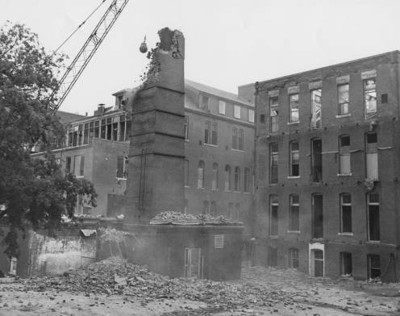![[Map of St. Paul's Hospital], Postcard, n.d.; (http://texashistory.unt.edu/ark:/67531/metapth121635/ : accessed December 01, 2015), University of North Texas Libraries, The Portal to Texas History, http://texashistory.unt.edu; crediting Dallas Heritage Village, Dallas, Texas.](http://blogs.library.unt.edu/southwest-metroplex/wp-content/uploads/sites/14/2015/12/metapth121635_l_1983.42.914_01-740x476.jpg)
[Map of St. Paul’s Hospital], Postcard, n.d.; (http://texashistory.unt.edu/ark:/67531/metapth121635/ : accessed December 01, 2015), University of North Texas Libraries, The Portal to Texas History, http://texashistory.unt.edu; crediting Dallas Heritage Village, Dallas, Texas.
Hospitals are often over-looked landmarks in a city’s history. For many people, though, hospitals are the backdrop of treasured first moments with children or last moments with parents. It can be a little sad to see a hospital close or, in the case of St. Paul Hospital in Dallas, demolished.
The original hospital building on Bryan Street, part of St. Paul’s Sanitarium, opened its doors on June 15, 1898, providing 110 beds to the Dallas community. The hospital was served by nurses of the Roman Catholic Order. In the decades following, a school of nursing and a school of medical technology were established. By 1963, 6 new buildings had been erected under the St. Paul name:
- An Annex building (1916) brought the bed capacity to 300.
- The School of Nursing building was finished in 1922.
- A five-story clinic building opened in 1938.
- “Mary’s Manor” (a dormitory for Nursing students) came to be in 1947.
- The Dallas Building brought the bed capacity to 395 in 1954.
- A 484-bed hospital in Southwestern Medical Center admitted its first patients in 1963.

Work, Jim. St. Paul Hospital on Bryan Street demolition. Dallas Medical Images Collection at UT Southwestern Archives.
St. Paul led the community in selflessness and innovation. Nurses risked their own lives when volunteering during the influenza outbreak of 1918, and they did the same again in 1951 when a five-alarm fire broke out at the hospital. Staff saved over 250 people without a single serious injury. In 1954, St. Paul was the first hospital in Dallas to allow African American doctors to serve at their institution. This was followed by desegregation in 1959.
Five years after the new hospital opened in the Southwestern Medical Center, the original hospital on Bryan Street was demolished. The photograph shown, part of the UT Southwestern digital archives, shows the building’s demolition.
For over fifty years, the hospital in Southwestern Medical Center, near the intersection of Harry Hines and Inwood, provided Dallas with superb care. In 1985, it became the first hospital in the city to perform a heart transplant.
On November 20, 2015, St. Paul Medical Center was demolished. William P. Clements Jr. University Hospital will take its place in serving the Dallas area with modern and innovative healthcare. The hospital is 12 floors and offers 460 beds.



Tanya Stracener
Thank you for posting this. I love St. Paul and its rich history. 🙂
Skye
I was born here 33 years ago and wondered what happened to the center. Thanks for the history.
stef p
The reference to “Southwest Metroplex” on the headline banner for this article is both misnomer and diction faux pas, and accordingly nonsensical; but that is not reason to feel humbled or defensive: great numbers of the population—including, not surprisingly, . . .the academic publishing population—have yet to come to grips with the Dallas, marketwise coinage even after so many decades. And, even so, you and NT are to be acknowledged for capitalizing Metroplex as an always proper(never improper) noun—never an English word in its own right even if you did not know that until now!
The first references to special names for sprawling, SMSA metropolises did, in fact, first find footing in the vernacular by their mention in some college classrooms– TTU comes to this writer’s recollection—as early as the late sixties and early seventies—concurrently in large measure with increasing readership and publicity in conjunction with Pauling’s The Population Bomb; but, it was not until more well along in the seventies that the marketing and political leadership in Dallas–by then becoming increasingly aware of the diminishment of the Dallas image-in the wake of such phenomena as white flight, migration of people/ businesses/pavement to the “new-generation” (rural) suburbs, and even such factors as the burgeoning reputation of Ft Worth as the more pleasant place for family life & house-holding—found it imperative to seek new ideas to offset its importance slide. It took no great leap to realize, say, that if the urbs outside city limits were destined to outgain in image, then what better way to compete than to incorporate them all under the Dallas sphere of influence; to make them all indistinguishable from the big city; and it was the =plex word—to replace –politan, that was to prove the perfect vehicle for getting the point across, both regionally as well as nationally. . . albeit that use of the word beyond state lines will sometimes be received with contempt, especially if one does not realize that there is only one metroplex and the world, which refers specifically to the word, Dallas. So you have only “the Metroplex” or the Dallas or DFW Metroplex—never the metroplex or anything else Metroplex. And if you want to be too clever and pretend the existence of a “Southwest Metroplex” such reference would indicate either:
• The southwest part of the Metroplex which would be at distance from Dallas in Tarrant County or points west.
• Or—loosely speaking—the southwest part of Dallas County
. . . neither of which was the intended meaning; so that “Southwest Metroplex”is and invalid and therefore meaningless terminology. If you wan to cover the razed St Paul Hospital it would be okay just to speak of the metroplex, even though it will seem a bit awkward. . . . or, better still, write and a true, scholastic periodical and dispense with the marketing blurbs altogether, which does not cast the publication under its intended, academic light.
David Saldivar
Wow! I was born there in 1968. I’m crying now!